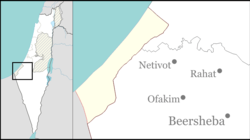Ta'ashur
תְּאַשּׁוּר تئاشور | |
|---|---|
| Hebrew transcription(s) | |
| • standard | Te'ashur |
| Etymology: Larch | |
| Coordinates: 31°22′20″N 34°38′38″E / 31.37222°N 34.64389°E | |
| Country | Israel |
| District | Southern |
| Council | Bnei Shimon |
| Affiliation | Moshavim Movement |
| Founded | 1953 |
| Founded by | Moroccan Jewish immigrants |
| Population (2022)[1] | 461 |
Ta'ashur (Hebrew: תְּאַשּׁוּר, lit. Larch) is a moshav in southern Israel. Located in the north-western Negev between Ofakim and Netivot, it falls under the jurisdiction of Bnei Shimon Regional Council and covers an area of around 1,200 dunams. In 2022 it had a population of 461.[1]
YouTube Encyclopedic
-
1/3Views:33 7673 358 96621 730
-
Ashur Ke Sooraj Kuch To Bata Kiya Ghuzri Ti Kiya Dekha Ta - Bohra Mersiya
-
Ziyarat Ashura - Abathar Al-Halawaji - زيارة عاشوراء ابا ذر الحلواجي
-
Shabbir Teri Mazloomi Par Ta Hashar Ye Gham Ho Ye Ga - Bohra Mersiya
Transcription
History
The moshav was established in 1953 by Moroccan Jewish immigrants and refugees. Its name is taken from the Book of Isaiah, specifically Isaiah 41:19:
I will plant in the wilderness the cedar, the acacia-tree, and the myrtle, and the oil-tree; I will set in the desert the cypress, the plane-tree, and the larch together;[2]
Two other nearby moshavim, Brosh (cypress) and Tidhar (plane-tree) take their name from this passage and the three of them are known as the Moshavei Yahdav (lit. the "Together Moshavim").
References
- ^ a b "Regional Statistics". Israel Central Bureau of Statistics. Retrieved 21 March 2024.
- ^ Isaiah 41 Mechon Mamre

